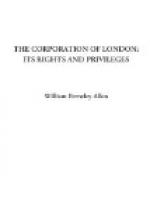But however distinguished may be the civic position, however great the moral influence, of the Lord Mayor and the Court of Aldermen, the controlling power is, after all, centred in the Common Council. At a very remote period the freemen of the City were accustomed to meet in general assembly, and to act as one body. As their numbers increased, the many inconveniences of such a mode of proceeding soon became manifest; and so early as the reign of the first Edward representatives began to be chosen from each ward for the despatch of real business. At first the guilds, or trading companies, claimed the right of election as their exclusive privilege, and consequently excited the jealousy of the mass of the inhabitants. It was therefore arranged that the men of each guild or “mystery” should choose their own delegates from among themselves, and this was the more easily accomplished, as at that time each craft occupied a separate quarter, as is still the custom in the East. This arrangement, however, was of brief duration, and a more permanent settlement was effected in the reign of Richard II. It was then agreed that every ward should annually elect four of the most efficient persons in the ward to sit in the Common Council for the following year, and whose names should be presented to the mayor —that high functionary being charged to accept no more than eight members of any one “mystery” for the whole city. As the wards varied in extent and population, it was further agreed that the larger wards should return six councillors, and the smaller four or two, according to their sufficiency. The number of the Common Council was then fixed at 96 members, but gradually increased to the present number of 206, who are chosen as follows:-
Bassishaw and Lime Street each return 4; Dowgate, Candlewick, Cordwainers, Cornhill, Queenhithe, Vintry, and Walbrook, 6; Bread Street, Bridge, Billingsgate, Broad Street, Cheap, Coleman Street, Cripplegate Within, and Cripplegate Without, Tower, Langbourn, Castle Baynard, Aldersgate, Aldgate, and Portsoken, 8; Bishopsgate and Farringdon-within, 14; and Farringdon-without, 16. These true representatives of the citizens constitute the Court of Common Council, under the style and title of “Court of the Lord Mayor, Aldermen, and Commoners of the City of London in Common Council assembled.” It requires the presence of the Lord Mayor, or his deputy—an alderman who has passed the chair—two aldermen and thirty-eight common councilmen, to make a quorum. There are usually twelve ordinary meetings in the year, and on an average thirteen extraordinary meetings, convened for special purposes by a requisition to the Lord Mayor signed by seven members. The proceedings are conducted as nearly as possible according to the routine of the House of Commons, and embrace a vast variety of subjects of local and sometimes national importance. The Court has a double function —legislative and executive. In the




